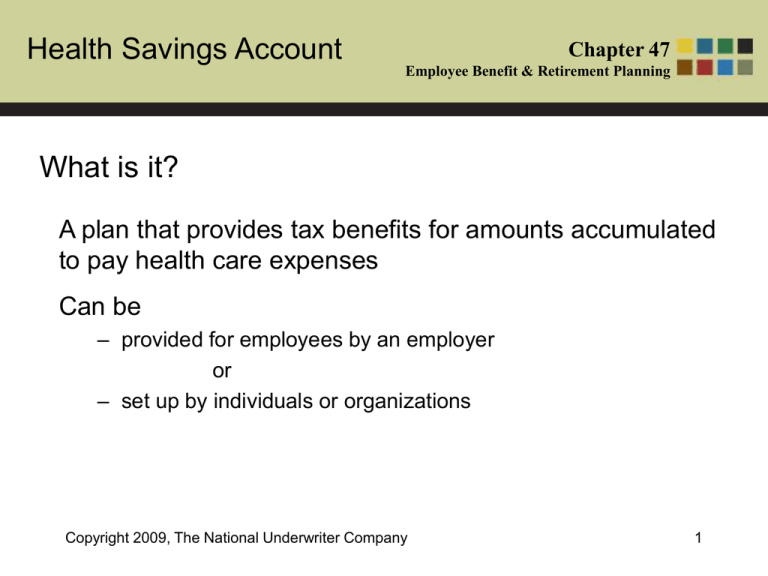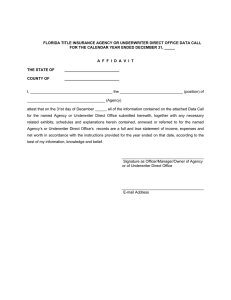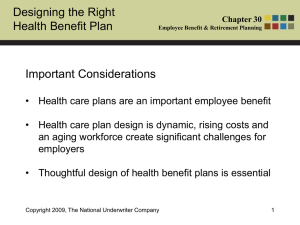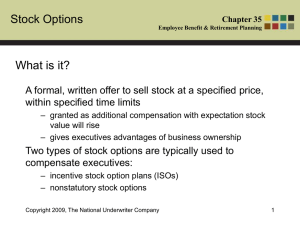Health Savings Account What is it? to pay health care expenses
advertisement

Health Savings Account Chapter 47 Employee Benefit & Retirement Planning What is it? A plan that provides tax benefits for amounts accumulated to pay health care expenses Can be – provided for employees by an employer or – set up by individuals or organizations Copyright 2009, The National Underwriter Company 1 Health Savings Account Chapter 47 Employee Benefit & Retirement Planning Major features 1. Annual individual or employer contributions to IRAlike plan to pay qualified medical expenses up to: – $3,000 for individual (2009) – $5,950 for family (2009) Copyright 2009, The National Underwriter Company 2 Health Savings Account Chapter 47 Employee Benefit & Retirement Planning Major features (cont’d) 2. High deductible health plan: – $1,150 individual deductible (2009) – $2,300 family deductible (2009) Maximum annual out-of-pocket – $ 5,600 for individual (2009) – $11,200 for family (2009) 3. Able to accumulate “savings” because amounts not used for medical expenses continue to grow tax-free Copyright 2009, The National Underwriter Company 3 Health Savings Account Chapter 47 Employee Benefit & Retirement Planning When is it Indicated? • When desire way to save on insurance costs • Can be used by self-employed and those not covered by employer plans as well as those who are Copyright 2009, The National Underwriter Company 4 Health Savings Account Chapter 47 Employee Benefit & Retirement Planning Advantages 1. Offer tax-saving opportunities to eligible individuals 2. Unused funds not forfeited at year-end; continue to grow tax-free inside HSA 3. No requirement that HSA be used to pay medical expenses 4. HSA not as flexible as IRA but qualified plan participant can contribute to HSA and not IRA regardless of income Copyright 2009, The National Underwriter Company 5 Health Savings Account Chapter 47 Employee Benefit & Retirement Planning Advantages 5. Proponents of HSA – people see cost of health care – shop for best price Opponents of HSA – without first dollar coverage, people will delay medical care until they need costly medical intervention Copyright 2009, The National Underwriter Company 6 Health Savings Account Chapter 47 Employee Benefit & Retirement Planning Disadvantages 1. HSAs do not appear appropriate for tailored benefit plans nor are they likely to extend health coverage to people currently without coverage 2. Lower income may see high deductibles as drastic cut in benefits 3. Taxpayers in lower income brackets get less tax benefit than other taxpayers 4. Structure may encourage adverse selection Copyright 2009, The National Underwriter Company 7 Health Savings Account Chapter 47 Employee Benefit & Retirement Planning Eligibility To contribute a person must be covered under highdeductible health plan Cannot be – covered under non-high deductible plan (e.g. under spouse plan) – enrolled in Medicare – be claimed as dependent on another’s tax return Copyright 2009, The National Underwriter Company 8 Health Savings Account Chapter 47 Employee Benefit & Retirement Planning Eligibility Person must be covered under high-deductible health plan Can be – covered by certain types of “permitted insurance” that doesn’t have high deductibles – in plan with low deductible or first dollar coverage for preventive care – adopted by employer or individual Copyright 2009, The National Underwriter Company 9 Health Savings Account Chapter 47 Employee Benefit & Retirement Planning Contributions • Aggregate annual contribution limit – $3,000 annually for individual (2009) – $5,950 annually for family (2009) • Limit is per individual or per family • Catch-up provision of $1000 (2009) for those 55 and older Copyright 2009, The National Underwriter Company 10 Health Savings Account Chapter 47 Employee Benefit & Retirement Planning Contributions Contributions cease at age 65 Contributions may be made – directly by individual – through salary reductions under employer cafeteria plan – directly by employers Copyright 2009, The National Underwriter Company 11 Health Savings Account Chapter 47 Employee Benefit & Retirement Planning Funding • HSA plans must be funded; no IRS permission required • Contributions must be in cash; investment restrictions exist • Trustee/custodian of HSA can also sell health insurance • Assets in HSA can accumulate without limit • Covered individual may withdraw funds at any time but may face penalty if not used for medical expenses Copyright 2009, The National Underwriter Company 12 Health Savings Account Chapter 47 Employee Benefit & Retirement Planning Plan Benefits Participants can use funds to pay for qualified medical expenses for self, spouse, dependents Distributions to pay medical expenses not taxable “Qualified medical expense” is any expense eligible for itemized medical expense deduction Cannot use HSA plan funds to pay employee share of health insurance premiums Copyright 2009, The National Underwriter Company 13 Health Savings Account Chapter 47 Employee Benefit & Retirement Planning Tax Implications 1. Contributions made by individual are “above the line”; cannot also take itemized deduction 2. Employer contributions under cafeteria plan are – tax deductible to employer – not taxable to employee – not subject to FICA and FUTA 3. Can make HSA contribution for eligible family member Copyright 2009, The National Underwriter Company 14 Health Savings Account Chapter 47 Employee Benefit & Retirement Planning Tax Implications 4. HSA distributions tax-free IF used to pay for qualified medical expense 5. Distributions for other than qualified medical expenses are taxable and subject to 10% penalty unless made after account beneficiary’s – death – disability – attainment of age 65 Copyright 2009, The National Underwriter Company 15 Health Savings Account Chapter 47 Employee Benefit & Retirement Planning ERISA Implications • Plans offered by employers are subject to ERISA welfare benefit plan rules • ERISA does not apply to plans adopted by individuals Copyright 2009, The National Underwriter Company 16 Health Savings Account Chapter 47 Employee Benefit & Retirement Planning Alternatives • Archer MSA • Health Reimbursement Arrangement (HRA) • Flexible spending arrangement (FSA) Copyright 2009, The National Underwriter Company 17 Health Savings Account Chapter 47 Employee Benefit & Retirement Planning Discussion Questions 1. Explain the difference between and HSA and an Archer Medical Savings Account. 2. Explain the “doughnut hole” in HSA coverage. 3. How are HSAs used in partnerships? Copyright 2009, The National Underwriter Company 18


